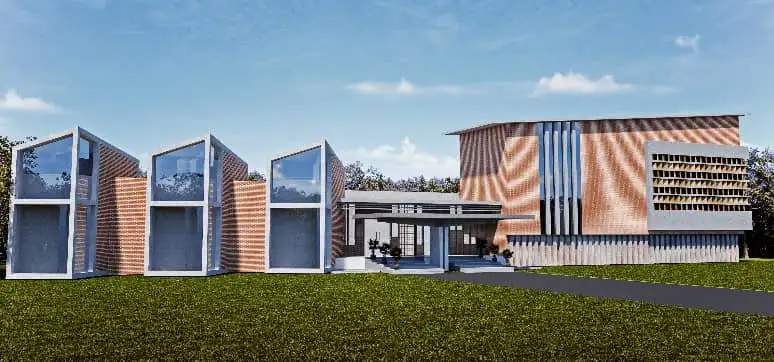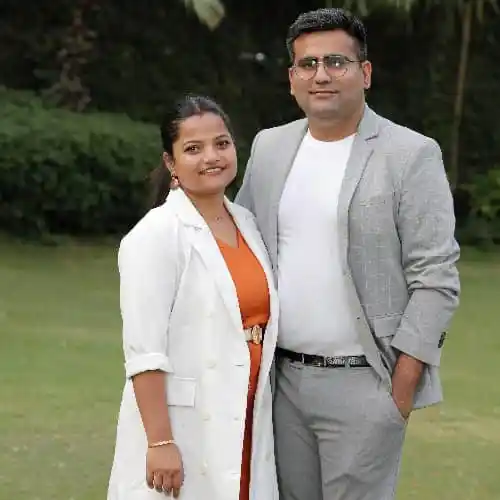Glass façades are the preferred choice of clients and designers for their buildings around the world. They are easy to install, and maintain and provide a clean appearance. In this decade, scenarios have changed especially in the cities, people are looking for alternative solutions that help them connect with nature or have a positive impact on the natural environment.
We as humans are so influenced by the West, that we try to imbibe the same everywhere. Ranging from fashion to food to buildings. But when we analyse the deep truth of life we realise that ranging from religions, settlements, and communities to food, everything is derived from the climate of the place. One cannot just do things isolated from context.

One cannot have a glass façade in the middle of the desert. It is also obvious that CSEB (compressed stabilised earthen blocks) is not suitable for snow-cladded hills. In the very humid Ganges plains, we cannot do without regular baths because we sweat profusely. On the other hand, in the deserts, there is a scarcity of water, or in the cities of Europe, which are covered with snow most of the year, one cannot bathe every day, which led to the innovation of perfumes. So climate plays an important role in the development of settlements, food, culture, traditions, and especially buildings.
Every material we use has a different impact on the environment. We all know that glass is to be used in areas that are comparatively colder than the temperature range in India. To control or improve the user experience various elements of heat and glare controls are to be used with glass which makes the façade more expensive. The construction industry has a huge contribution to the rising environmental conditions including the carbon footprints in which façades play a predominant role.
As a designer, our primary role is to blend the basic design elements with the use of climatology, sun movement pattern, and data to develop a space that acts as the center of user interaction spaces.

Museums are buildings or structures that hold culture, history, science, and stories. The design of the built form is designed to cultivate the scientific pursuit and create a different façade that plays with light and shadow. Our team has put immense thought and effort into creating a structure that not only stands out visually but also prioritises sustainability and energy efficiency.
The façade of any building plays a crucial role in making a lasting impression and setting the tone for its surroundings. It not only serves as a distinguishing feature but also allows for optimal incidence of natural light and creates a harmonious blend of aesthetics and functionality.
Case Study
Science Museum Tikhali Dam, Nuapada, Odisha
The site is situated at the top of Tikhali Dam in Nuapada, Odisha, which falls into the humid climatic zone with strong sun and glare and huge reflections from water in the dam. As a designer, we felt the need for the building to self-cool, and control the heat flow entering inside the building. The whole concept revolves around the Evolution, Enhancement, and Enrichment of humanity.
The project illustrates the idea of developing a dam that will lead to improved opportunities in the surrounding community and create various job and business opportunities for everyone with revenue from the surrounding states as a tourist attraction for families.
The façade with a large area was exposed to the west side, where the water reservoir of the dam was located, which increased the heat gain during the day. Brick was a good choice for heat reduction as a façade element with observatories in different places to enjoy the view of the dam and the landscape. The usage of terracotta clay Jaalis reduces direct sunlight and the ingress of heat. The Jaalis also add beautiful patterns to the façade design.

One of the key advantages of our design is the use of a brick façade, which offers numerous sustainable benefits when compared to traditional glass façades. Bricks are synonymous with a learning experience, of sustainability with locally produced bricks being the material of choice to create a harmonious relationship with an environment that touches the timelessness with its earthy touch. The brick façade acts as a natural insulator, reducing heat transfer and minimising the need for excessive energy consumption for temperature control. This translates to both cost savings and reduced environmental impact in the long run.
FAÇADE & FENESTRATIONS – A BLEND OF BRICK AND GLASS
The designers have strategically incorporated window slits and ribbon windows throughout the building’s design to optimise daylighting. By allowing natural light to flood in, we have significantly reduced reliance on artificial lighting in common areas such as the lobby. This not only creates a pleasant environment for occupants but also reduces energy consumption during daylight hours.

To maintain cost-effectiveness without compromising on quality, we have utilised double-glazed units (DGU) glass combined with aluminium frames. This combination offers durability, thermal insulation properties, and affordability – all essential factors when considering long-term sustainability. The design of the WWR (wall-to-window ratio) was based on a value between 40% and 60%.
To further enhance the experience, we incorporate terracotta clay jaali in strategic areas to carefully control direct light incidence, ensuring a comfortable balance within the space. The sloped ceiling allows to place of solar panels directly on the ceiling to increase reliance on renewable resources. On the northern façade, big double-glazed glass panels allow for maximising the catchment of natural light
AESTHETICS

Any successful public building will focus on urban user interaction and community building. The design of the project is inspired by the rich cultural heritage of Odisha. The rendering and the waveform of the bricks are inspired by the coast of Odisha. It depicts beautiful art forms from Odisha like Odissi dancers, Konark Chakra, or temples on the walls. This contextual connection adds an element of cultural pride while ensuring that the building blends harmoniously with its surroundings.
The façade has to strike a balance between various perspectives like aesthetics, project cost, impact on the environment, energy consumption and occupant’s well-being. The main focus of the building design is to increase the interaction of the building with its users. The internal cutouts with large staircases act as a common interaction area.
Façade engineering and its integration with data are important aspects to be considered while designing any project. Various data modeling techniques and tools were used for the museum project for placing the observatory, window opening, Jaali, and fenestrations.

At the studio, our processes were collaborative, and researched and the data led to drive to conclusions. We are working to make the use of glass façades more sustainable rather than blindly following the trend and to imply it as per the Indian Climatic Standards.
The only step we feel to attain is to observe the data, follow data-based mapping of design, and overall evaluate the energy flow in the project.
QUICK FACTS:
- Project: Science Museum
- Location: Tikhali Dam, Nuapada, Odisha
- Client: Govt. of Odisha
- Design Firm: Furnish ME
Architects, New Delhi - Principal Architect: Ar. AmritaJena
- Design Team: Ar. Amrita Jena, Ar. Akshay Kapoor, Ar. Shashi
Kumar, Saurav, Uttkarsh - Structural Consultants: Er. Richa. Srija Consultants.















